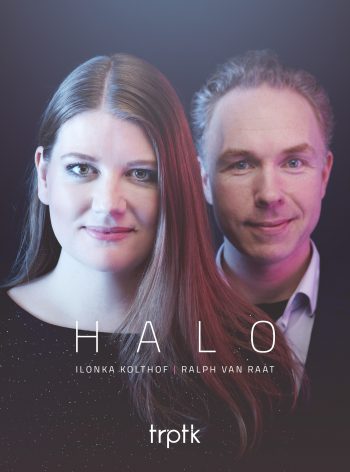Music for piano and percussion, music that can be more expressive and explosive than any other duo imaginable. The beautiful sonority of a big Fazioli grand piano, combined with the raw force and timbral structure of a giant set of percussion, and even some electronics here and there.
|
|
This title is available as:
About the album
Music for piano and percussion, music that can be more expressive and explosive than any other duo imaginable. The beautiful sonority of a big Fazioli grand piano, combined with the raw force and timbral structure of a giant set of percussion, and even some electronics here and there.
Jan-Peter de Graaff’s The Bells of St. Clement’s is a work in three movements based on the English nursery rhyme “Oranges and Lemons”. This nursery rhyme plays in important role in the novel “1984” by Orwell. In it, the nursery rhyme is a symbol of the notion that the promise of freedom in a totalitarian society might be another form of oppression, where hope is a terrible illusion.
Yannis Kyriakides’ Once There Was is a suite of pieces based on traditional nursery rhymes as well. Many of these rhymes have dark and historically significant themes, yet are used to foster emotion and cultivate language. In some cases, rhymes were censored to mask the political message that lie within.
In Moritz Eggert’s piece The Collectors, the composer wants to find a way to tell the story of how music is collected, how it consists of sounds and ideas and events that slowly begin to make sense because they are arranged in a certain order. To collect is to try finding meaning in a seemingly disordered world. Eggert has always had the feeling it secretly makes a lot of sense. Both the world and collecting.
Samuel Penderbayne’s Shameless is a short, dense and theatrical work. His primary stimulus for the piece was to find the point where physical instrumental virtuosity combines effectively with theatrical performance. This can be seen in three main sections: the first is a sort of cat-and-mouse between percussion and piano; the second is a loud and shameless cacophony of yelling, piano clusters and gongs; the final part is a relatively soft and withdrawn meditation that should give the work a surprisingly calm finish.
The Dutch Golden Collection was founded by Konstantyn Napolov to develop percussion instruments, search and create new music languages, extend the repertoire for solo and chamber music, and promote the created contemporary works worldwide. Popularisation of percussion instruments and creating new masterworks is one of the key aims of The Dutch Golden Collection.
Tracklist click to play/pause
-
Jan-Peter de Graaff
The Bells of St. Clemens
-
I. Oranges and lemons
8:338:33
-
II. The chopper
5:195:19
-
III. A place without darkness
3:483:48
-
-
Yannis Kyriakides
Once There Was
-
I. On a wall, in a beck
1:441:44
-
II. Here comes a candle
4:304:30
-
III. A garden full of snow
3:233:23
-
IV. Until the sun
2:592:59
-
V. XYZ and ampersand
1:571:57
-
VI. All the birds in the air
4:494:49
-
VII. Black wool
1:471:47
-
-
Moritz Eggert
The Collectors
27:1327:13
-
Samuel Penderbayne
Shameless
3:413:41
More information
| Weight | 100 g |
|---|---|
| Dimensions | 190 × 135 × 12 mm |
| Label | TRPTK |
| Genre(s) | Classical – Contemporary (> 1920) |
| Artist(s) | Eke Simons Konstantyn Napolov |
| Composer(s) | Eggert, Moritz Graaff, Jan-Peter de Kyriakides, Yannis Penderbayne, Samuel |
| Recording location(s) | Theater aan het Spui - Grote Zaal, The Hague (NL) |
| Recording date(s) | July 2018 |
| Cat. No. | TTK 0027 |
|---|---|
| Release date |
August 19th, 2018 |
| Additional links |
"Even listening in regular stereo you can’t believe your own ears, let alone when this happens in surround sound. The feeling persists that the musicians are performing in your room. […] In other words, whatever you can say about the music, what is in order here is the highest possible opinion of the artisan profession that is music."
Aart van der Wal, Opus Klassiek
"Behind every composition is its own story that is being told by Konstantyn Napolov and Eke Simons. They paint fascinating musical landscapes full of subtleties, tension, and sonic atmospheres."
Ruud Jonker, Music Emotion
"The work of Kyriakides stands out in its obscurity, Eggert proposes a good dose of humor."
Merlijn Kerkhof, De Volkskrant
Further reading
Related products
-

The Fiery Angel
Maya Fridman
Artem BelogurovCD
€ 3,75 | TTK0009 -

Introductio
Postscript
CD
€ 7,50 | TTK0045 -

Elegy
Aeon Trio
CD
€ 7,50 | TTK0010 -

Shalygin: Todos Los Fuegos El Fuego
Amstel Quartet
Keuris Quartet2-CD
€ 9,00 | TTK0050 -

Blackbird (r)evolution
Duo Ebano
CD
€ 7,50 | TTK0048 -

Halo
Ilonka Kolthof
Ralph van RaatCD
€ 7,50 | TTK0044




